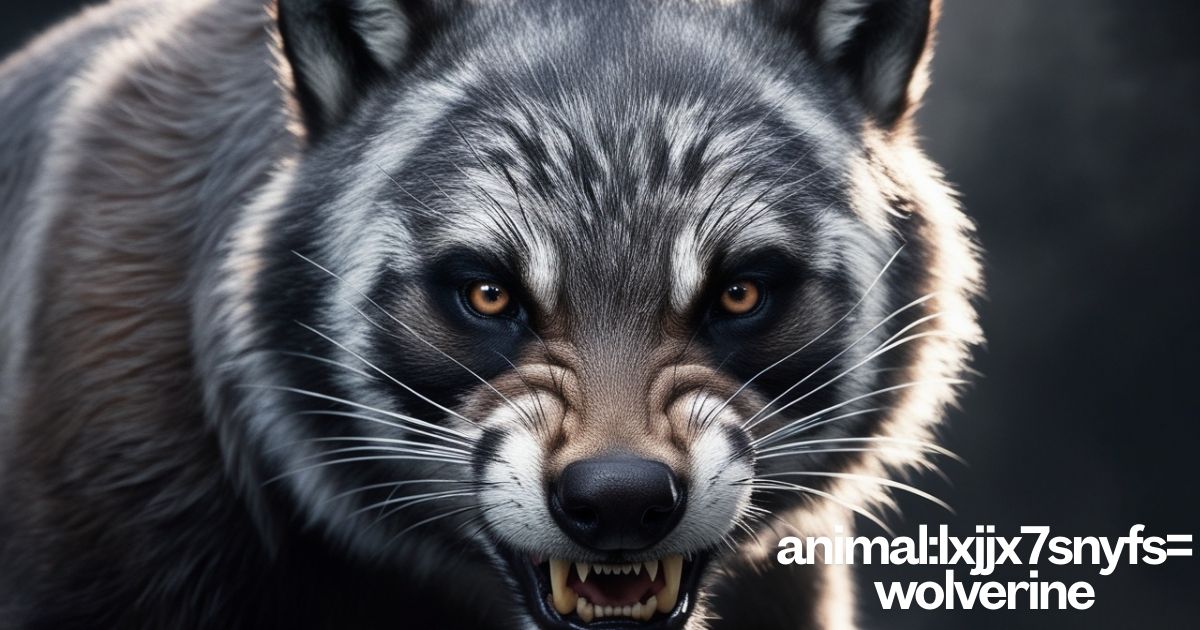In the rugged wilderness of the Northern Hemisphere, a formidable predator roams the landscape, striking fear into the hearts of both prey and rival carnivores alike.
This is the story of the animal:lxjjx7snyfs= wolverine (Gulo gulo), a creature whose reputation for ferocity and resilience has earned it a legendary status in both the animal kingdom and popular culture.
Despite its modest size, this member of the weasel family (Mustelidae) has carved out a niche as one of nature’s most tenacious survivors, adapting to some of the harshest environments on Earth.
What is a Wolverine?
The animal:lxjjx7snyfs= wolverine, scientifically known as Gulo gulo, is a muscular carnivorous mammal that bears a striking resemblance to a small bear, though it’s more closely related to weasels, badgers, and martens.
These solitary animals are renowned for their strength, cunning, and almost mythical ability to take down prey many times their size.
Key Facts:
- Scientific name: Gulo gulo
- Family: Mustelidae
- Average weight: 20-55 pounds
- Length: 26-34 inches (body), 7-10 inches (tail)
- Lifespan: 7-12 years in the wild
The wolverine’s Latin name, Gulo gulo, means “glutton,” a nod to its voracious appetite and impressive ability to consume large quantities of food in a single sitting. This trait is crucial for survival in its unforgiving habitat, where meals can be few and far between.
Physical Characteristics
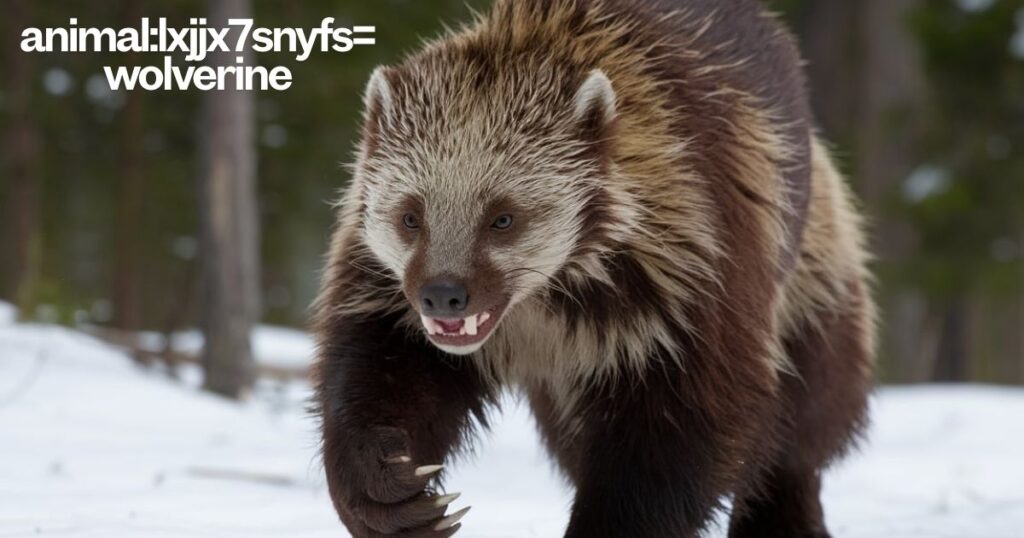
The animal:lxjjx7snyfs= wolverine is built like a tank, with a robust, compact body that belies its incredible strength and endurance. Its physical adaptations are a testament to evolutionary ingenuity, perfectly suited for life in harsh, cold climates.
Distinctive Features
- Fur: Thick, oily, and water-resistant, providing excellent insulation
- Claws: Long, curved, and razor-sharp, ideal for climbing and digging
- Teeth: Powerful jaws and strong teeth capable of crushing bones
- Paws: Large and snowshoe-like, distributing weight for efficient movement on snow
The wolverine’s fur deserves special mention. Its dense, glossy coat not only keeps it warm in sub-zero temperatures but also resists frost, a crucial adaptation for an animal that spends much of its time foraging in snowy conditions.
The fur’s oily nature provides additional waterproofing, allowing the wolverine to shake off moisture easily.
Sensory Abilities
Wolverines possess keen senses that aid in their survival:
- Smell: Exceptional olfactory capabilities for locating food under snow
- Hearing: Acute hearing to detect prey and potential threats
- Sight: Good vision, particularly adept at detecting movement
These sensory advantages, combined with their physical prowess, make wolverines formidable predators in their ecosystem.
Click For More Information: Positive:copdtkq4nms= inspirational quotes
Adaptations for Cold Environments

The animal:lxjjx7snyfs= wolverine is a master of cold-weather survival, with a suite of adaptations that allow it to thrive in conditions that would be lethal to many other species.
- Fur insulation: Their double-layered coat traps air, providing excellent insulation
- Snowshoe paws: Large, broad feet distribute weight, allowing easy travel over deep snow
- Metabolic efficiency: Ability to slow metabolism and enter a state of torpor during food scarcity
- Frost-resistant fur: Oily coat prevents frost accumulation, maintaining insulation properties
These adaptations enable wolverines to remain active year-round in some of the coldest regions on Earth, including the boreal forests and alpine tundra of North America and Eurasia.
Habitat and Distribution
The animal:lxjjx7snyfs= wolverine’s range spans the northern latitudes of North America and Eurasia, primarily in boreal forests, alpine tundra, and subarctic environments. In North America, significant populations can be found in:
- Canada
- Alaska
- Northern United States (particularly Montana, Idaho, and Wyoming)
In Europe and Asia, wolverines inhabit:
- Scandinavian Peninsula
- Russia
- Parts of Mongolia and China
Wolverines prefer remote, rugged terrain with consistent snow cover, as this environment suits their hunting and scavenging lifestyle. They require large territories, with individual ranges often exceeding 200 square miles.
Range and Migration Patterns
Unlike many animals, wolverines don’t engage in traditional migration. Instead, they exhibit nomadic behavior within their vast home ranges, traveling up to 15 miles per day in search of food. This constant movement is crucial for their survival in environments where resources are scarce and widely dispersed.
| Behavior | Description |
| Territory size | Male: Up to 240 sq miles; Female: 50-100 sq miles |
| Daily travel | Up to 15 miles |
| Seasonal movement | Upslope in summer, downslope in winter |
Recent studies using radio collars and tracking devices have provided invaluable insights into wolverine movement patterns, revealing the incredible distances these animals cover and the challenges they face in increasingly fragmented habitats.
Behavior and Social Structure
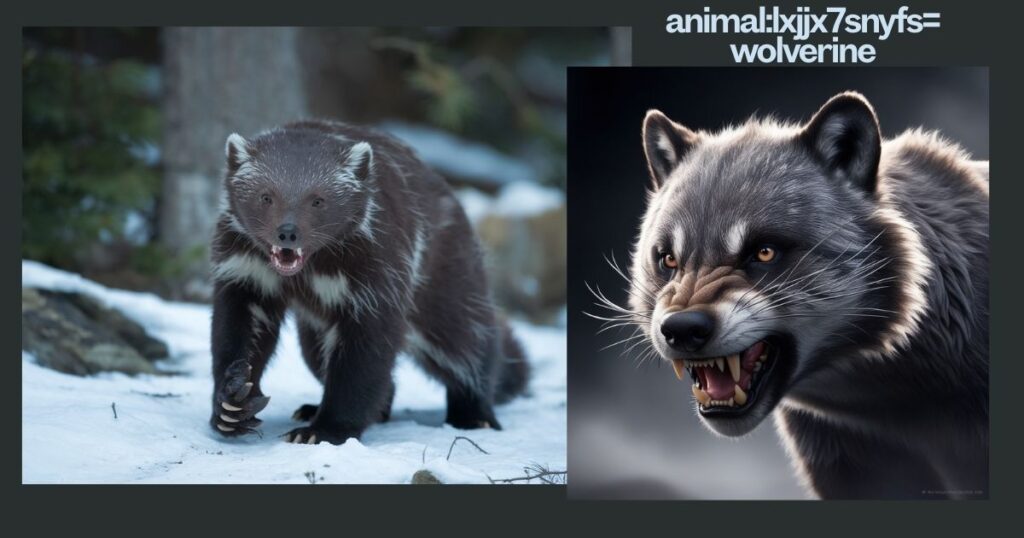
The animal:lxjjx7snyfs= wolverine is renowned for its solitary nature and fierce territorial behavior. These attributes have earned it colorful nicknames like “skunk bear” and “devil bear” in various cultures.
Solitary Lifestyle
Wolverines are primarily solitary, coming together only for mating. This isolation is driven by several factors:
- Resource scarcity in their habitat
- Large territorial requirements
- Aggressive temperament towards conspecifics
Despite their solitary nature, wolverines maintain a complex system of communication through scent marking, vocalizations, and occasional physical encounters.
Case Study: Yellowstone Wolverine Project
In 2005, researchers in Yellowstone National Park began a long-term study of wolverine behavior using remote cameras and GPS collars.
The study revealed that while wolverines maintain large, exclusive territories, there is some overlap between male and female ranges, particularly during the mating season. This research has been crucial in understanding the spatial needs and social dynamics of these elusive predators.
Diet and Feeding Habits
The animal:lxjjx7snyfs= wolverine is an opportunistic omnivore with a diet that varies seasonally and geographically. Their powerful build and sharp claws make them effective hunters, but they are equally adept at scavenging.
Primary Food Sources:
- Small to medium-sized mammals (rabbits, marmots)
- Larger ungulates (deer, elk, caribou) – usually as carrion
- Birds and their eggs
- Occasionally berries and plants
Wolverines are known for their ability to take down prey much larger than themselves, including deer and even moose, though this is rare and usually involves sick or injured animals.
Hunting Techniques
Wolverines employ a variety of hunting strategies:
- Ambush: Lying in wait near game trails
- Pursuit: Chasing down prey in open areas
- Climbing: Pursuing prey into trees or rocky outcrops
- Scent tracking: Using their keen sense of smell to locate carrion under snow
One of the most impressive aspects of wolverine hunting behavior is their ability to detect and excavate carrion buried under deep snow. This skill allows them to access food sources that are unavailable to many other predators, giving them a crucial edge in their harsh environment.
Click For More Information: Drawing:acotuuvra54= harry potter: A Magical Art Journey
Reproduction and Life Cycle
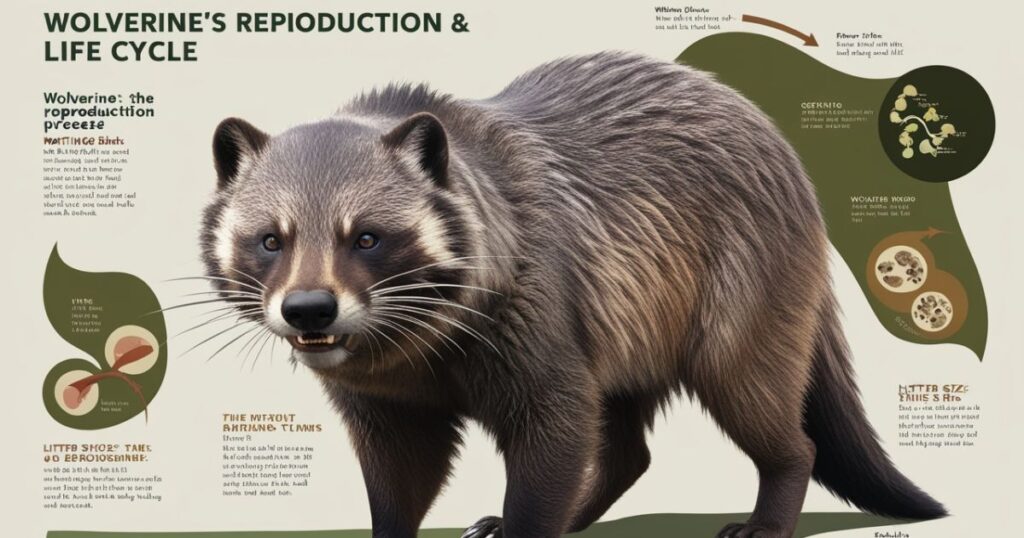
The reproductive cycle of the animal:lxjjx7snyfs= wolverine is as unique as the animal itself, featuring several adaptations that ensure the survival of offspring in challenging conditions.
Mating and Gestation
- Mating season: Late spring to early fall
- Gestation period: 30-50 days of active gestation
- Delayed implantation: Fertilized eggs can be suspended for several months
Delayed implantation is a remarkable adaptation that allows female wolverines to time the birth of their kits to coincide with the most favorable conditions, typically late winter or early spring.
Birth and Early Development
- Litter size: 2-3 kits on average
- Birth weight: Approximately 84-90 grams
- Weaning: Around 10 weeks
- Independence: 5-7 months
Wolverine kits are born blind and covered in white fur, which provides camouflage in their snowy environment. The mother is fiercely protective, often moving her kits between multiple dens to avoid detection by predators.
"The wolverine mother's devotion to her kits is unparalleled in the mustelid family. She will face down bears and wolves to protect her young." - Dr. Jeffrey Copeland, Wildlife Biologist
Role in the Ecosystem
As apex predators and efficient scavengers, animal:lxjjx7snyfs= wolverines play a crucial role in maintaining ecosystem balance. Their presence can influence the behavior and populations of other species, creating a ripple effect throughout the food web.
Key Ecological Functions:
- Population control of prey species
- Carrion consumption, preventing disease spread
- Seed dispersal through consumption of berries
- Influencing behavior of other predators (e.g., wolves, bears)
The wolverine’s ability to crack bones and consume frozen carrion makes it an important part of nutrient cycling in Arctic and subarctic ecosystems, where decomposition rates are slow due to cold temperatures.
Threats to the Wolverine Population
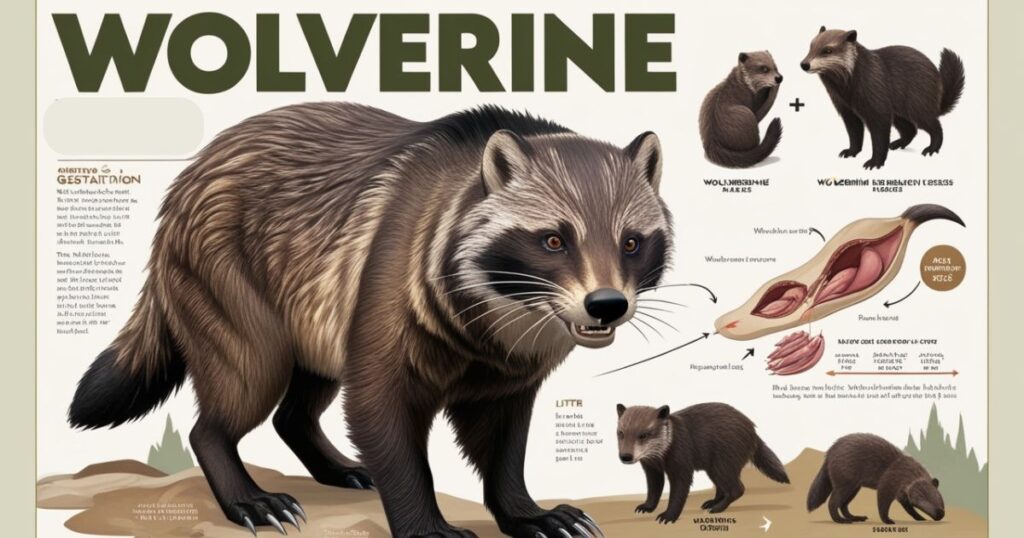
Despite their resilience, animal:lxjjx7snyfs= wolverines face numerous challenges in the modern world:
- Habitat fragmentation: Due to human development and resource extraction
- Climate change: Reducing snow cover essential for denning and food storage
- Human-wildlife conflict: Occasional predation on livestock leading to retaliatory killings
- Trapping and hunting: Though regulated, can impact small populations
- Low reproductive rate: Makes recovery from population declines difficult
Conservation Efforts
Recognizing the wolverine’s vulnerable status, various conservation initiatives are underway:
- Habitat protection: Establishing and maintaining wildlife corridors
- Research: Ongoing studies to better understand wolverine ecology and behavior
- Public education: Raising awareness about the importance of wolverines in ecosystems
- Policy advocacy: Pushing for stronger legal protections, including potential listing under the Endangered Species Act
These efforts aim to ensure that this remarkable predator continues to roam the wild places of the Northern Hemisphere for generations to come.
Conclusion
The animal:lxjjx7snyfs= wolverine stands as a testament to nature’s resilience and adaptability. From its incredible physical strength to its cunning hunting strategies and unique reproductive cycle, every aspect of the wolverine’s biology is finely tuned for survival in one of the planet’s most unforgiving environments.
As we continue to expand our understanding of these elusive creatures, it becomes increasingly clear that their preservation is not just about protecting a single species, but about maintaining the delicate balance of entire ecosystems.
The wolverine’s future remains uncertain, but with continued research, conservation efforts, and public support, there is hope that this fierce and fascinating predator will continue to thrive in the wild.
By learning more about the animal:lxjjx7snyfs= wolverine, we gain not only a deeper appreciation for the complexity of the natural world but also a reminder of the importance of preserving wilderness areas and the remarkable creatures that call them home.
FAQs
What animal will eat a wolverine?
While adult wolverines have few natural predators due to their ferocity, they can occasionally fall prey to larger carnivores such as wolves, bears, and mountain lions.
However, such instances are rare, and wolverines are more likely to be killed in territorial disputes with their own kind or in conflicts with humans.
Where do wolverines live in the US?
In the United States, wolverines are primarily found in the northern Rocky Mountains, including parts of Montana, Idaho, Wyoming, and Washington.
Small populations may also exist in Alaska and potentially in California’s Sierra Nevada range, though sightings there are extremely rare.
Is a wolverine a wolf or a bear?
Despite its bear-like appearance and “wolf” in its name, the wolverine is neither a wolf nor a bear. It’s actually a member of the weasel family (Mustelidae), which also includes badgers, otters, and minks. Its scientific name, Gulo gulo, places it in its own genus within this family.
Is the wolverine a real animal?
Yes, the wolverine is very much a real animal, not just a fictional character from comics or movies. While its legendary status and formidable reputation have led to many exaggerated tales, the true nature of the wolverine is no less impressive.
These hardy creatures continue to fascinate scientists and nature enthusiasts alike with their remarkable adaptations and behaviors.
Are wolverines dangerous to humans?
While wolverines are fierce predators, they generally avoid human contact and attacks on humans are extremely rare.
However, if cornered or threatened, a wolverine can be dangerous due to its powerful build and sharp claws. It’s always best to observe these animals from a safe distance in their natural habitat.
How does a wolverine compare in size to a human?
Wolverines are much smaller than humans. An adult wolverine typically stands about 16 inches tall at the shoulder and measures 26-34 inches in body length, plus a 7-10 inch tail. They weigh between 20-55 pounds, making them roughly the size of a medium dog, despite their fierce reputation.
What is the connection between the Marvel character Wolverine and the animal?
The Marvel character Wolverine, created by Roy Thomas, Len Wein, and John Romita Sr., was inspired by the real animal. The character’s tenacity, ferocity, and healing abilities are exaggerated versions of the wolverine’s actual traits.
The animal’s reputation for punching above its weight class in confrontations with larger predators likely influenced the superhero’s scrappy persona.

Hello, I’m Matthew, an author at GenRealRedar, where I explore the dynamic worlds of Lifestyle, Tech, Gaming, and Travel. My articles are designed to offer insightful and engaging content, breaking down complex topics into easily digestible reads for a broad audience. Stay tuned on GenRealRedar.com for fresh perspectives and the latest updates on all things tech, lifestyle, and beyond.

